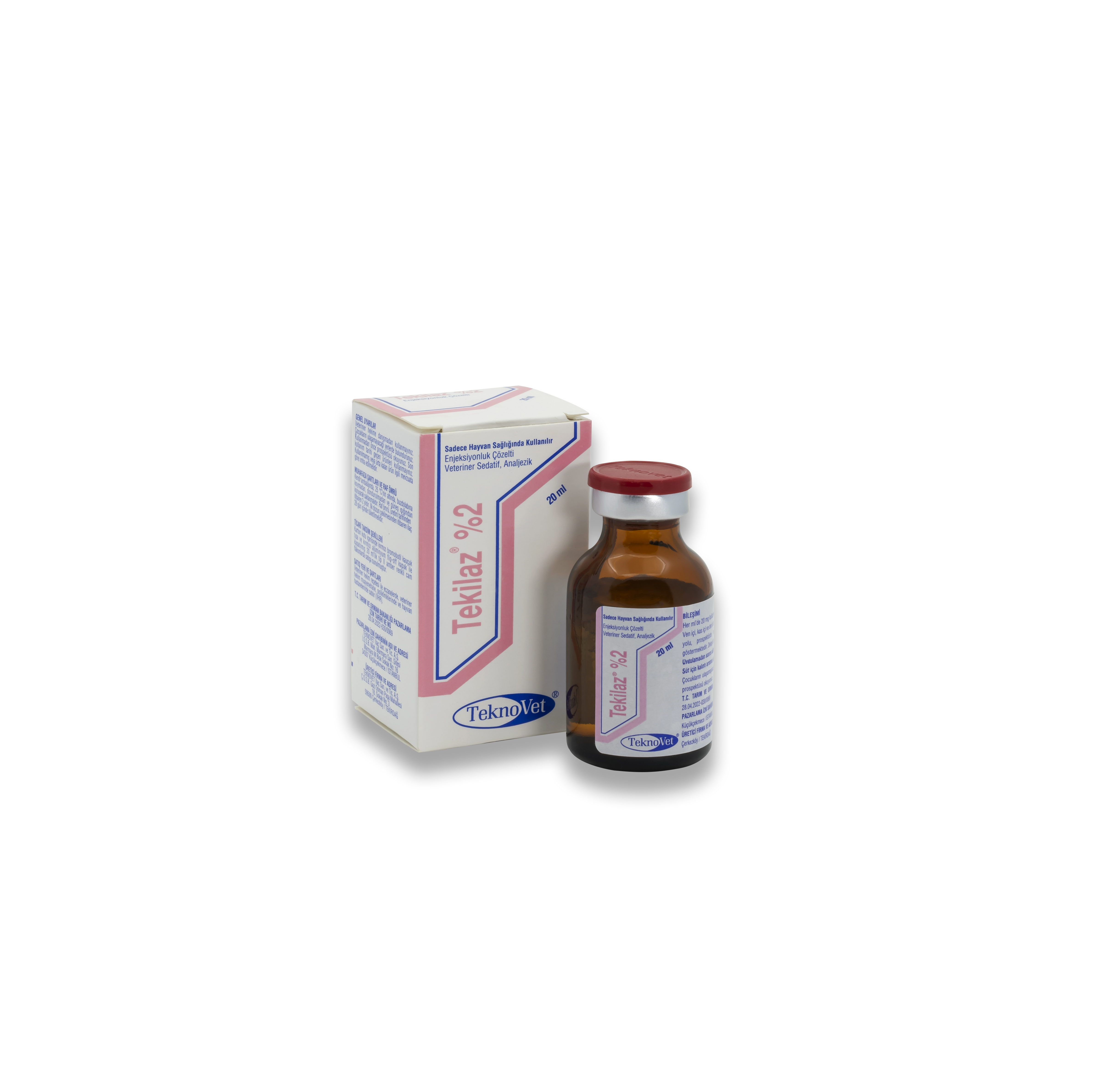COMPOSITION
Each ml contains xylazine HCl equivalent to 20 mg xylazine, 1.0 mg methyl parahydroxybenzoate (E 218) and 0.1 mg propyl parahydroxybenzoate (E 216) as a preservative.
INDICATIONS FOR USE
Cattle:
It is used to provide sedation, muscle relaxation and analgesia in minor operations and also for premedication for general anesthesia.
Horse:
It is used for sedation and muscle relaxation, as well as for premedication to be combined with other suitable products for anesthesia and analgesia.
Cat and dog:
It is used to provide sedation and also for muscle relaxation, anesthesia and analgesia in combination with other suitable products.
ADMINISTRATION ROUTES AND AMOUNTS
It is administered intravenously, intramuscularly and subcutaneously.
The dose to be administered varies in accordance with the purpose stated below.
Dose 1: Sedation and analgesia are significant and sufficient for minor interventions.
Dose 2: Moderate sedation with muscle relaxation and analgesia occurs and is sufficient for surgical interventions.
Dose 3: All effects are very pronounced and this dose allows for significant surgical interventions. In most cases, animals cannot stand.
Dose 4: Long-term sedation and intense muscle relaxation. These animals should not have been given food.
It usually needs slightly higher doses in untamed, aroused and nervous animals. Older, sick, or heavily exerted animals are more sensitive to the drug and respond more intensely. If necessary, the effect of the drug can be increased with the second application. The total dose should not exceed Dose 4.
CATTLE:
Intramuscular administration;
| Dose |
Mg/kg |
Required products for 100 kg body weight (ml) |
Required product for 500 kg body weight (ml) |
| Dose 1 |
0.05 |
0.25 |
1.25 |
| Dose 2 |
0.1 |
0.5 |
2.5 |
| Dose 3 |
0.2 |
1 |
5.0 |
| Dose 4 |
0.3 |
1.5 |
7.5 |
Slow intravenous administration:
| Dose |
Mg/kg |
Required products for 100 kg body weight (ml) |
Required product for 500 kg body weight (ml) |
| Dose 1 |
0.016-0.024 |
0.08-0.12 |
0.4-0.6 |
| Dose 2 |
0.034-0.05 |
0.17-0.25 |
0.85 - 1.25 |
| Dose 3 |
0.068 to 0.10 |
0.33 to 0.5 |
1.65 - 2.5 |
For intravenous administration, 1/2 or 1/3 of the intramuscular administration doses are recommended, depending on individual response. With intravenous administration, the effect occurs more quickly and the duration of action is generally shorter.
HORSE:
It is administered intravenously.
Sedation: At a dose of 0.6-1.0 mg/kg body weight (3-5 ml product per 100 kg), it provides mild to strong sedation and analgesia and muscle relaxation varying from animal to animal, depending on the dose. Standing is maintained.
Anesthesia protocols for horses;
Protocol 1: Xylazine-barbiturates: 2.4 ml of product per 100 kg is administered intravenously, after 5-10 minutes 600-700 ml of the following mixture is infused; 50 g guaifenesin+2 g thiopental 1 liter NaCl.
Protocol 2: xylazine-halothane or xylazine fluothane: 4 ml of product per 100 kg is administered intravenously and after the effect is achieved, anesthesia is provided by intubation.
Protocol 3: Xylazine-ketamine: 5 ml of product per 100 kg is administered intravenously, after 3-5 minutes 220 mg of ketamine per 100 kg is administered intravenously. Sleeping occurs within 1 minute.
DOG
It is administered intramuscularly or intravenously.
It provides mild to strong sedation and analgesia and muscle relaxation varying from animal to animal, depending on the dose, by administration at a dose of 1-3 mg/kg body weight (0.5-1.5 ml product for 10 kg).
Anesthesia protocols for dogs;
Protocol 1: Xylazine-ketamine
1 ml of product per 10 kg of body weight is administered intravenously and half of 100 mg of ketamine per 10 kg of body weight is administered intramuscularly and half intravenously.
Protocol 2: Xylazine-barbiturates
0.5-1 ml of product per 10 kg body weight intramuscular (with atropine premedication) barbiturates (for example, intravenous 1/3-1/4 of the normal dose (7.5 mg/kg) thiopental)
Protocol 3: Xylazine-halothane
0.5 ml of the product per 10 kg of body weight is administered intramuscularly, after 10 minutes the continuation of anesthesia with intravenous barbiturates (eg thiopental at a dose of 7.5 mg/kg) and halothane intubation
CAT
It is administered intravenously or subcutaneously.
Administration at a dose of 2-4 mg/kg (0.1-0.2 ml of product per 1 kg of body weight) provides muscle relaxation, moderate-intensity sedation and analgesia varying from individual to individual.
Anesthesia protocols for cats:
Protocol 1: Xylazine-ketamine
0.1 ml of product and 10 mg of ketamine per 1 kg of body weight by intramuscular route.
Protocol 2: xylazine-barbiturates
0.5 ml product per 10 kg body weight intramuscularly (with atropine premedication) After 10 minutes intravenous barbiturates (e.g. thiopental at 1/3-1/4 of the normal dose (5 mg/kg))
Protocol 3: xylazine-halothane-fluothane
Prolongs the duration of intubation or inhalation anesthesia with xylazine barbiturates.
WITHDRAWAL PERIOD(S)
Cattle should not be slaughtered for 1 day following the last treatment. Withdrawal period for milk is 0 (zero) days following the last treatment.
MARKETING PACKAGING
Sold as 20 ml type II amber colored glass sealed with red bromobutyl rubber stopper and red aluminum flip-off lid in cardboard boxes.
